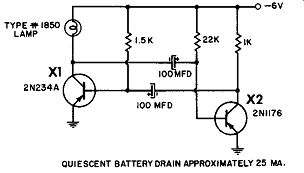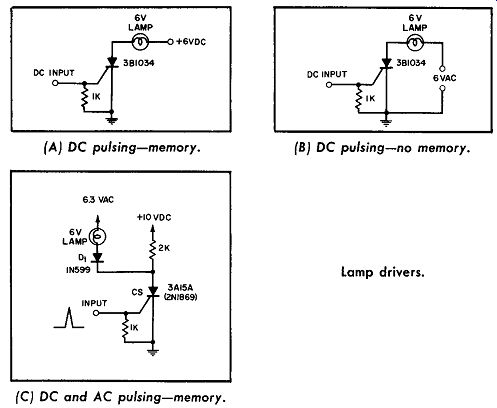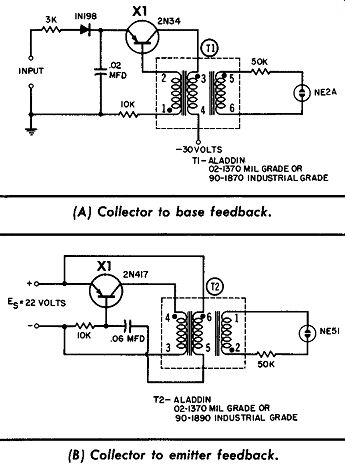AMAZON multi-meters discounts AMAZON oscilloscope discounts
Indicators are neon or incandescent lamps used to show the on or off state of a given circuit ( somewhat like a pilot light). They are very important in computer circuits such as counters. In this application, the indicators actually show, by visual means, what number is held in the counter.
In tube circuits, the voltage and current are high enough to light a neon lamp or heat up an indicator-light filament. But in solid-state circuits, the applied voltage is usually too low for a neon lamp, and the current is too low for lamp heaters. Thus special techniques, discussed in this section, are used.
LIGHT FLASHER

-------------- Light flasher.
+Using a 2N234A and a 2Nll76 in a free-running oscillator circuit, this transistorized light flasher provides a flash repetition rate of about 60 per minute. The low quiescent current drain of about 25 ma assures long life, and the transistors do not require heat sinks. A single 6-volt source is adequate.
Reducing the value of the capacitors will increase the flash repetition rate, whereas increasing their value will decrease the rate.
LAMP DRIVERS
Lamp drivers are used to indicate the condition of a counter, logic circuit, or shift register or to light a lamp in many applications. Three methods of lighting 6-volt lamps are shown here.
These are typical approaches to using semiconductor-controlled rectifiers ( SCR'S) in lamp-driving circuits. The circuit in Part A takes advantage of the bistable memory characteristic of the SCR when used with a DC voltage supply. The lamp and SCR are in series with the DC supply. The SCR can be triggered on by a positive pulse or a DC voltage level at the input terminal. For the 3Bl034, the triggering requirement is 2 volts. Once triggered, the SCR will remain on until reset by momentarily interrupting the anode current, which turns off the lamp. Just as with a thyratron, the SCR gate regains control if an AC anode voltage is used.
In Part B, an AC supply is used and the circuit no longer has a memory. When a DC signal is applied to the input, the SCR will pass current to the lamp during each positive half-cycle of the supply. When the input signal is removed, the SCR turns off on the first negative half-cycle-remaining off until an input signal is again applied.
(A) DC pulsing-memory. (B) DC pulsing-no memory. (C) DC and AC pulsing-memory.

------- Lamp drivers.
The SCR acts like a high-gain power transistor-with the additional advantage of eliminating a DC power supply for the lamp circuit, since the SCR rectifies the lamp current.
In the circuit in Part C, memory action is achieved by combining DC and AC supplies. Two advantages are thus provided.
First, the lamp power is obtained from the AC supply, reducing the DC power requirements. Second, only a small amount ( 5 to 10 ma) of DC load current is necessary to hold the SCR on when the AC supply is negative. To turn off the SCR, it is necessary only to interrupt the relatively small DC anode current.
NEON LAMP DRIVERS
Neon lamps in computers or data-processing circuits with vacuum tubes have a high enough voltage to fire the neon light.
But neon indicator lights in transistorized data-processing systems present a problem, because the 60 to 90 volts needed to fire a neon tube is not easily available. However, if as little as 12 volts DC is present, this problem can be solved by using a transistor oscillator and a tiny step-up transformer for each bulb.

------ Neon lamp drivers. (A) Collector to base feedback. (B) Collector to emitter
feedback.
Two typical oscillator circuits are shown, using miniature trans formers to produce a voltage output large enough to light a neon bulb. Part A shows a transistor oscillator circuit employing collector-to-base feedback. The circuit does not go into oscillation, however, until a signal is applied to the input. Thus, the 30-volt supply may be permanently connected, and oscillation controlled, by the presence or absence of a low-voltage signal or trigger pulse.
The circuit will go into oscillation and light the bulb when the input is as low as +3 volts with respect to ground.
The transistor oscillator circuit in Part B employs collector-to emitter feedback. Operation is similar to that of a free-running blocking oscillator operating at a 50% duty cycle. The waveform is thus more like a square than a sine wave. Lighting of the bulb is controlled entirely by the presence or absence of the 22-volt supply; no trigger voltage is needed.
INDICATOR LAMP DRIVER
In this figure, two transistors are used as a lamp driver for a computer indicator. Use of complementary transistors keeps standby (off) current low. The circuit is bistable, and requires input pulses of 2 volts maximum to light the lamp. Applied at Point A, negative pulse turns the lamp on. Because of circuit regeneration, the lamp stays on. A positive input pulse turns the circuit off.

-------------- Indicator lamp driver.
TRIGGER PULSE REQUIREMENT VOLTS MAXIMUM AMBIENT TEMPERATURE -55°C TO 71°C RESISTOR TOLERANCE! 10% AT END OF LIFE